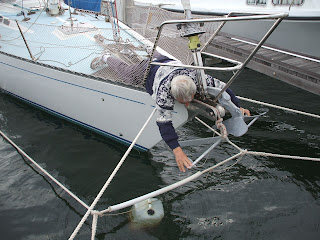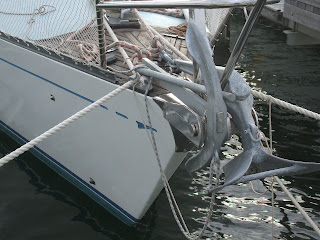


I sorted out some anchor issues yesterday to great relief and satisfaction. The main question was how to store and deploy the Swarbrick Fisherman-style anchor. Fisherman anchors are probably the best all-around anchors (e.g. they punch through weed, cling to rock crevices, hold in mud and sand) but they have gone out of favour largely because they are so difficult to store and deploy.
The attached photos show the Swarbrick 35lb anchor on the starboard roller next to the Manson 45-lb plow. You can see that the plow anchor can be dropped and retrieved with no interference from the Swarbrick. To deploy the Swarbrick I (1) push the anchor to where it is hanging vertically from the roller (2) pull back on the trip line to steady the anchor and also raise it a bit from the water (3) on my stomach I position the stock. When I get to the drop point I'll ease the trip line and gently drop the anchor. Retrieval is the reverse: bring the anchor up to the roller, steady it with the trip line, move the stock to the storage position, then yank the anchor onto the roller.
The stomach operation is better than it looks: easy on the back, safe because I am down low, and requires no risky movements. Approaching an anchorage in rough conditions could pose a problem, but you've got to ask how suitable would be an anchorage where the bow of the boat is plunging in and out of the water. Nevertheless if such conditions do arise I'll drop the plow anchor.
Note that the ropes were experimental only. My 38m of 10mm chain is being re galvanised. I'll probably purchase a 15m chain for the second anchor. Both anchors will have 100 meters or so of 16mm nylon rope. Also, Scotty is fabricating generous stainless steel armor for the bow to protect it from swinging anchors.
Harley Swarbrick phoned me last week to tell me that he expected to put together this week the 50lb anchor that I have ordered. The span across the arms and the length of shank of the larger anchor are less than 100mm (4") more than those of the 35lb anchor, so I anticipate no problem with putting it on the roller.
So which are the primary and secondary anchors? Who knows. I'll probably start out with the Swarbrick 35lb and the Manson plow anchors on the roller, as show on the photos. Each anchor has its advantages, so I'll drop one or the other depending on what I think is the holding ground. The Swarbrick 50lb will be a storm anchor.
One of the problems of an S&S 39 is that it is sensitive to weight at the bow because its forward section is so long and slender. That is one reason why I can't have all-chain rodes. So I'll store the Swarbrick 50lb and spare chain at the stern to trim the boat.
All peer reviews welcome!







